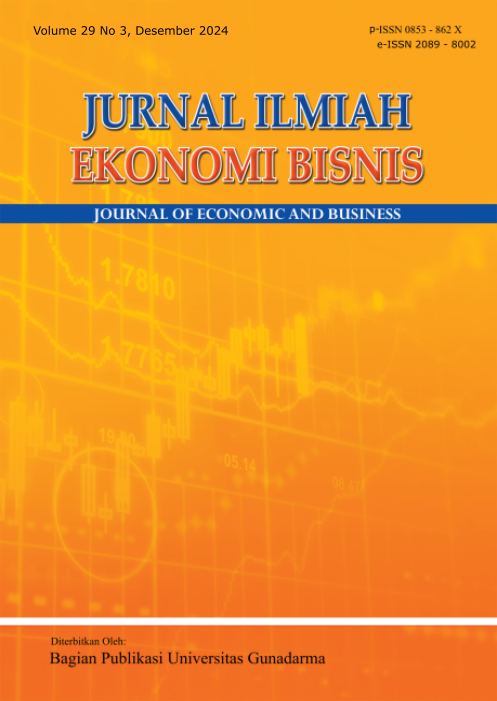PREDICTING THE JAPANESE YEN'S VOLATILITY IN RELATION TO THE INDONESIAN RUPIAH
Politeknik Statistika STIS
Indonesia
Politeknik Statistika STIS
Indonesia
Politeknik Statistika STIS
Indonesia
Politeknik Statistika STIS
Indonesia
Politeknik Statistika STIS
Indonesia
Abstract
Japan has experienced low inflation and continuous deflation since the economic bubble of the 1980s. Following the COVID-19 pandemic, the world was preoccupied with deflation in various countries, worsening Japan's financial condition. As a result, the Japanese currency's exchange rate could not compete with other currencies. This situation significantly affects the value of Indonesia's exports and imports, as Japan is one of the leading export destinations and a primary supplier of implications for Indonesia. The purpose of this study is to forecast the volatility of the exchange rate between the yen and the IDR for the future. The data used in this research is the buying rate variable from the yen to IDR exchange rate data from January 3, 2020, to November 27, 2023. The method used for the high-volatility data is the GARCH model. The best modeling obtained is GARCH(0,1). The forecast results provide an insight into the buying exchange rate of the yen against the IDR until the beginning of 2024.
Keywords
References
Abdullah, S. M., Siddiqua, S., Siddiquee, M. S. H., & Hossain, N. (2017). Modeling and forecasting exchange rate volatility in Bangladesh using GARCH models: a comparison based on normal and Student’s t-error distribution. Financial Innovation, 3(18), 1-19. doi.org:10.1186/s40854-017-0071-z.
Aftab, M., Syed, K. B. S., & Katper, N. A. (2017). Exchange-rate volatility and Malaysian-Thai bilateral industry trade flows. Journal of Economic Studies, 44(1), 99–114. doi.org:10.1108/JES-05-2015-0091.
Anjuita, A., Rahayu, W., & Siregar, D. (2023). Intervention analysis for modeling and forecasting exchange rates rupiah against yen. Sainmatika: Jurnal Ilmiah Matematika dan Ilmu Pengetahuan Alam, 20(1), 47–57. doi.org:10.31851/sainmatika.v20i1.9209
Asteriou, D., Masatci, K., & Pilbeam, K. (2016). Exchange rate volatility and international trade: International evidence from the MINT countries. Economic Modelling, 58, 133–140. doi.org:10.1016/j.econmod.2016.05.006.
Atalan, A. (2020). Is the lockdown important to prevent the COVID-19 pandemic? Effects on psychology, environment and economy-perspective. Annals of Medicine and Surgery, 56, 38–42. doi.org:10.1016/j.amsu.2020.06.010
Bank Indonesia. (2023). Kurs transaksi yen Jepang terhadap rupiah. Retrieved from: https://www.bi.go.id/id/statistik/informasi-kurs/transaksi-bi/default.aspx
Bank of Japan. (2023). Bank of Japan interest rates. Retrieved from: https://www.stat-search.boj.or.jp/index_en.html#
Beckmann, J., & Czudaj, R. L. (2022). Exchange rate expectation, abnormal returns, and the COVID-19 pandemic. Journal of Economic Behavior and Organization, 196, 1–25. doi.org:10.1016/j.jebo.2022.02.002.
Bollerslev, T. (1986). Generalized autoregressive conditional heteroskedasticity. Journal of Econometrics, 31(3), 307–327. doi.org:10.1016/0304-4076(86)90063-1.
Bonam, D., & Smădu, A. (2021). The long-run effects of pandemics on inflation: Will this time be different? Economics Letters, 208(2021), 1-4. doi.org:10.1016/j.econlet.2021.110065.
Botman, D., De, I., Filho, C., Lam, W. R., We, I. Q., Danninger, S., Blanchard, O., Schiff, J., & Philips, S. (2013). The curious case of the yen as a safe haven currency: A forensic analysis. IMF Working Paper 13/228.
Box, G. E. P., & Jenkins, G. M. (1976). Time series analysis: Forecasting and control (2nd ed). San Fransisco: Holden-Day.
BPS. (2023). Volume ekspor menurut negara tujuan utama (Berat bersih: ribu ton), 2000-2022.
Brooks C. (2014). Introductory econometrics for finance (3rd ed., Vol. 9). New York: Cambridge University Press.
Chakraborty, I., & Maity, P. (2020). COVID-19 outbreak: Migration, effects on society, global environment and prevention. Science of The Total Environment, 728, 138882. doi.org:10.1016/j.scitotenv.2020.138882.
Charfi, S., & Mselmi, F. (2022). Modeling exchange rate volatility: application of GARCH models with a normal tempered stable distribution. Quantitative Finance and Economics, 6(2), 206–222. doi.org:10.3934/qfe.2022009.
Chaudhary, G., Hashmi, S., & Khan. Muhammad. (2016). Exchange rate and foreign trade: A comparative study of major South Asian and South-East Asian Countries. 3rd International Conference on New Challenges in Management and Organization: Organization and Leadership, 85–93. doi.org:10.1016/j.sbspro.2016.09.011.
Cheval, S., Adamescu, C. M., Georgiadis, T., Herrnegger, M., Piticar, A., & Legates, D. R. (2020). Observed and potential impacts of the Covid-19 pandemic on the environment. In International Journal of Environmental Research and Public Health, 17(11), 1–25. doi.org:10.3390/ijerph17114140.
Chit, M. M. M., Rizov, M., & Willenbockel, D. (2008). Exchange rate volatility and exports: New empirical evidence from the emerging East Asian Economies. The World Economy, 33(2), 239-263. doi.org:10.1111/j.1467-9701.2009.01230.x.
Chortane, S. G., & Pandey, D. K. (2022). Does the Russia-Ukraine war lead to currency asymmetries? A US dollar tale. The Journal of Economic Asymmetries 26, e00265. doi.org:10.1016/j.jeca.2022.e00265.
Salvatore. (2013). Ekonomi internasional 11E . Nashville, TN: John Wiley & Sons.
Eklou, K. (2023). Dollar exchange rate volatility and productivity growth in emerging markets: Evidence from firm level data. IMF Working paper, WP/23/111. doi.org:10.2139/ssrn.4484773.
Engle R F. (1982). Autoregressive conditional heteroscedasticity with estimates of the variance of United Kingdom inflation. Econometrica, 50, 987–1007.
European Central Bank. (2023). European Central Bank interest rate. Retrieved from: https://id.investing.com/economic-calendar/interest-rate-decision-164
Faris, M. (2023). Analyzing volatility jumps in the international monetary system: Impact of Russia-Ukraine conflict on currency exchange rates. SSRN Electronic Journal. Retrieved from: https://ssrn.com/abstract=4509577. doi.org:10.2139/ssrn.4509577.
Feng, G. F., Yang, H. C., Gong, Q., & Chang, C. P. (2021). What is the exchange rate volatility response to COVID-19 and government interventions? Economic Analysis and Policy, 69, 705–719. doi.org:10.1016/j.eap.2021.01.018.
Friedman, M. (1970). A theoretical framework for monetary analysis. Journal of Political Economy, 78(2), 193–238. Retrieved from: http://www.jstor.org/stable/1830684.
Fulk, G. (2023). Descriptive statistics, an important first step. Journal of Neurologic Physical Therapy, 47(2), 63–63. Ovid Technologies (Wolters Kluwer Health). doi.org:10.1097/npt.0000000000000434.
Gabriel, A. S. (2012). Evaluating the forecasting performance of GARCH models: Evidence from Romania. Procedia - Social and Behavioral Sciences, 62, 1006–1010. doi.org:10.1016/j.sbspro.2012.09.171
Ghani, I. M. M., & Rahim, H. A. (2019). Modeling and forecasting of volatility using ARMA-GARCH: Case study on Malaysia natural rubber prices. IOP Conference Series: Materials Science and Engineering, 48(1), 012023. doi.org/10.1088/1757-899x/548/1/012023.
Ginting, C. P., & Kartiasih, F. (2019). Analisis ekspor kopi Indonesia ke negara-negara Asean. Jurnal Ilmiah Ekonomi dan Bisnis, 16(2), 143–157. doi.org:10.31849/jieb.v16i2.2922.
Hanifah, N., & Kartiasih, F. (2018). Determinan impor serat kapas di Indonesia tahun 1975-2014 (Pendekatan Error Correction Mechanism). Media Statistika, 11(2), 119–134. doi.org:10.14710/medstat.11.2.119-134.
Hill, R.C., Griffiths, W. E., & Lim, G.C.(2011). Principles of Econometrics (4th ed., Vol. 14). New Jersey: John Wiley & Sons, Inc.
Huq, M.M., Rahman, M.M., Rahman, M.S., Shahin, Md. A., & Ali, Md, A. (2013). Analysis of volatility and forecasting general index of Dhaka Stock Exchange. American Journal of Economics, 3(5), 229–242. doi.org:10.5923/j.economics.20130305.04
Indriyani, S. (2016). Analisis pengaruh inflasi dan suku bunga terhadap pertumbuhan ekonomi di Indonesia tahun 2005 – 2015. Jurnal Manajemen Bisnis Krisnadwipayana, 4(2), 1-11.
Islam, M. A. (2013). Estimating volatility of stock index returns by using symmetric Garch models. Middle East Journal of Scientific Research, 18(7), 991–999. doi.org/10.5829/idosi.mejsr.2013.18.7.11806
Jabara, C. L. (2009). How do exchange rates affect import prices? Recent economic literature and data analysis. Retrieved from: chrome-extension://efaidnbmnnnibpcajpcglclefindmkaj/https://www.usitc.gov/publications/332/ID-21.pdf
Kafle, K. R. (2011). Exchange rate volatility and bilateral agricultural trade flows: the case of the United States and OECD countries (Master's theses). Louisiana State University, 3713. Retrieved from https://repository.lsu.edu/gradschool_theses/3713
Kannan, K., & Balamurugan, S. (2022). Modelling and forecasting of stock price volatility of selected nifty 50 companies in India. Open Access Repository, 8(7), 27–34. doi.org:10.17605/OSF.IO/VQ8FM.
Kartiasih, F. (2019). Inflasi dan siklus bisnis politik di Indonesia. Media Trend, 14(2), 219–228. doi.org:10.21107/mediatrend.v14i2.4978.
Kartiasih, F., Ramadhani, A. R, Fitri, K.A. & Aselnino, P. (2022). Faktor-faktor yang mempengaruhi volume impor jagung Indonesia dari lima negara eksportir terbesar tahun 2009-2021. INOVASI: Jurnal Ekonomi, Keuangan dan Manajemen, 18(4), 936–946.
Krishnaprabha, S., & Vijayakumar, M. M. (2015). A study on risk and return analysis of selected stocks in India. International Journal of Engineering Technologies and Management Research, 3(4), 79-86.
Laksono, R., & Edison, A. (2020). Analysis of the effect of real exchange rate on trading balance case study of Indonesia-Japan bilateral trade relations (MLR and J-Curve conditions). Solid State Technology, 63(3), 2735–2747. Retrieved from: www.solidstatetechnology.us.
Li, D., Magud, N. E., & Valencia, F. (2022). Financial shocks and corporate investment in emerging markets. Journal of Money, Credit and Banking, 52, 613–644.
Ma, M., Du, J., & Lai, K. K. (2014). Modeling volatility of exchange rate of Chinese Yuan against US Dollar based on GARCH models. Proceedings - 2013 6th International Conference on Business Intelligence and Financial Engineering, BIFE 2013, 295–299. doi.org:10.1109/BIFE.2013.63
Mamilla, R., Kathiravan, C., Salamzadeh, A., Dana, L.-P., & Elheddad, M. (2023). COVID-19 pandemic and indices volatility: Evidence from GARCH Models. Journal of Risk and Financial Management, 16(10), 447. doi.org:10.3390/jrfm16100447
Mankiw, & Gregory, N. (2008). Makroekonomi (6th ed.). Jakarta: Erlangga.
Maurya, P. K., Bansal, R., & Mishra, A. K. (2023). Russia–Ukraine conflict and its impact on global inflation: an event study-based approach. Journal of Economic Studies, 50(8), 1824–1846). doi.org:10.1108/jes-01-2023-0003.
Muchlas, Z., Stie, D., Agus, A. M., Alamsyah, R., & Malang, A. (2015). Faktor-faktor yang mempengaruhi kurs rupiah terhadap dolar Amerika pasca krisis (2000-2010). Jurnal JIBEKA, 9(1), 76–86.
Mukhlis, I. (2011). Analisis volatilitas nilai tukar mata uang rupiah terhadap dolar. Journal of Indonesian Applied Economics, 5(2), 172–182.
Ningsih, Y. P., & Kartiasih, F. (2019). Dampak guncangan pertumbuhan ekonomi mitra dagang utama terhadap indikator makroekonomi Indonesia. Jurnal Ilmiah Ekonomi dan Bisnis, 16(1), 78–92. doi.org:10.31849/jieb.v16i1.2307
Nishimura, Y., & Hirayama, K. (2013). Does exchange rate volatility deter Japan-China trade? Evidence from pre- and post-exchange rate reform in China. Japan and the World Economy, 25–26, 90–101. doi:10.1016/j.japwor.2013.03.002
Patel, P. (2014). Factors affecting currency exchange rate, economical formulas and prediction models. International Journal of Application or Innovation in Engineering & Management, 3(3), 53–56.
Pele, D., Lazar, E., & Dufour, A. (2017). Information entropy and measures of market risk. Entropy, 19(5), 1-19. doi.org:10.3390/e19050226.
Poon, S. H., & Granger, C. W. (2003). Forecasting volatility in financial markets: A review. Journal of Economic Literature, 41, 478–539.
Ramoni-Perazzi, J., & Romero, H. (2022). Exchange rate volatility, corruption, and economic growth. Heliyon, 8(12), 1-11. doi.org:10.1016/j.heliyon.2022.e12328.
Rusiadi, Aprilia, A., Adianti, V., & Verawati. (2020). Dampak Covid-19 terhadap stabilitas ekonomi dunia (Studi 14 negara berdampak paling parah). Jurnal Kajian Ekonomi dan Kebijakan Publik, 5(2), 173-182.
Sihaloho, E., D. (2020). Dampak Covid-19 terhadap perekonomian Indonesia. OSF Preprints Departemen Ilmu Ekonomi Universitas Padjadjaran. Retrieved form: https://www.researchgate.net/publication/345682307_Dampak_Covid-19_Terhadap_Perekonomian_Indonesia. doi.org:10.13140/RG.2.2.14524.67205/1.
Satriana, E. D., Harianto, & Priyarsono, D. S. (2019). Pengaruh volatilitas nilai tukar terhadap kinerja ekspor utama pertanian Indonesia. Buletin Ilmiah Litbang Perdagangan, 13(2), 163–186. National Research and Innovation Agency. doi.org:10.30908/bilp.v13i2.424.
Senadza, B., & Diaba, D. D. (2018). Effect of exchange rate volatility on trade in Sub-Saharan Africa. Journal of African Trade, 4(1–2), 20-36. doi.org:10.1016/j.joat.2017.12.002
Setiawan, A., & Kartiasih, F. (2021). Contagion effect krisis Argentina dan Turki ke negara-negara Asia, benarkah terjadi? Jurnal Ekonomi dan Pembangunan Indonesia, 21(Januari), 59–76. doi.org:10.21002/jepi.2021.05.
Simanjuntak, T. M., & Dermawan, D. (2023). Pengaruh perang Rusia dan Ukraina terhadap perekonomian di Negara Indonesia. Jurnal Pendidikan Tambusai, 7(3), 24923–24930.
Subanti, S., Hakim, A. R., Riani, A. L., Hakim, I. M., & Nasir, M. S. (2019). Exchange rate volatility and exports: A panel data analysis for 5 ASEAN countries. Journal of Physics: Conference Series, 1217(1), 012089. doi.org:10.1088/1742-6596/1217/1/012089.
Vo, D., Vo, A., & Zhang, Z. (2019). Exchange rate volatility and disaggregated manufacturing exports: Evidence from an emerging country. Journal of Risk and Financial Management, 12(1), 1-25. doi:10.3390/jrfm12010012.
World Bank. (2023). Inflation, consumer prices (annual %). International Monetary Fund, International Financial Statistics and Data Files. Retrieved from: https://data.worldbank.org/indicator/FP.CPI.TOTL.ZG
Xu, J., Khan, K., & Cao, Y. (2023). Conflict and exchange rate valuation: Evidence from the Russia-Ukraine conflict. Heliyon, 9(6), 1-9. doi.org:10.1016/j.heliyon.2023.e16527.
Zhang, Z., Raza, M. Y., Wang, W., & Sui, L. (2023). Volatility predictability in crude oil futures: Evidence based on OVX, GARCH and stochastic volatility models. Strategy Reviews, 50(2023), 1-12. doi.org:10.1016/j.esr.2023.101209.


